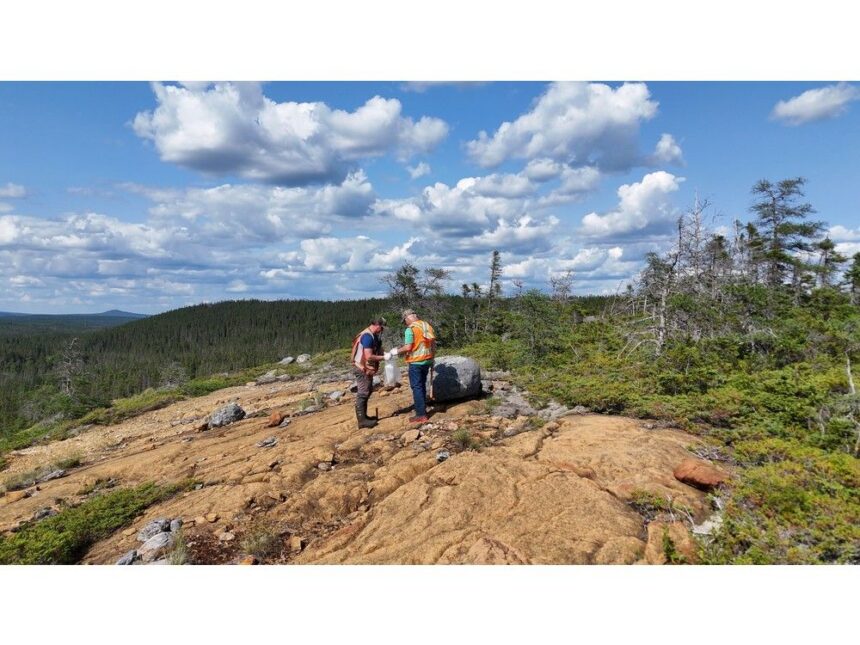First Atlantic Nickel is confident it can cleanly mine nickel from two sites in NL and has partnered with researchers interested in harnessing clean energy from the locationsAuthor of the article: Gary Kean • The TelegramPublished Apr 30, 2025 • 5 minute readA crew from First Atlantic Nickel visits the central Newfoundland site where the company hopes to develop a nickel mine and is also exploring the potential to harness geological hydrogen as a clean energy source. CONTRIBUTEDWhen anyone hears talk of ophiolite complexes in Newfoundland and Labrador — and knows what they are — they likely think of the four barren mountainous areas along the island’s west coast where the Earth’s mantle protrudes up from the surface.But the Lewis Hills, Blow-Me-Down Mountains, North Arm Hills and The Tablelands aren’t the only places where the Earth’s crust — usually below ground in most parts of the world — has broken the ground in the province.THIS CONTENT IS RESERVED FOR SUBSCRIBERS ONLY.Subscribe now to access this story and more:Unlimited access to the website and appExclusive access to premium content, newsletters and podcastsFull access to the e-Edition app, an electronic replica of the print edition that you can share, download and comment onEnjoy insights and behind-the-scenes analysis from our award-winning journalistsSupport local journalists and the next generation of journalistsSUBSCRIBE TO UNLOCK MORE ARTICLES.Subscribe or sign in to your account to continue your reading experience.Unlimited access to the website and appExclusive access to premium content, newsletters and podcastsFull access to the e-Edition app, an electronic replica of the print edition that you can share, download and comment onEnjoy insights and behind-the-scenes analysis from our award-winning journalistsSupport local journalists and the next generation of journalistsRegister to unlock more articles.Create an account or sign in to continue your reading experience.Access additional stories every monthShare your thoughts and join the conversation in our commenting communityGet email updates from your favourite authorsSign In or Create an AccountorArticle contentIt’s two such areas on the island of Newfoundland that First Atlantic Nickel Corp., a Vancouver, BC-based mining company, is targetting.While the company is mainly interested in the nickel resources found in the two ophiolite complexes, it has also entered into a research partnership with the Colorado School of Mines to explore geologic hydrogen as an energy source in the two areas.Where are they?The areas of interest are the St. Anthony Ophiolite Complex, a 103-square-kilometre area on the Northern Peninsula where the company has what it’s calling the Atlantis Project, and the Pipestone Ophiolite Complex, a 71-square-kilometre area in central Newfoundland where the company has its Atlantic Nickel Project.Article contentRather than the awe-inspiring sights of the four mountainous ophiolite complexes in western Newfoundland, the one near St. Anthony, on the tip of the Northern Peninsula, and the one about 40 kilometres south of Grand Falls-Windsor are both low-lying areas where the mantle has barely been thrust up to be visible.Is this different from Voisey’s Bay?The company is mostly excited about the nickel resources in these areas, particularly because it differs from the sort of nickel currently being mined at Voisey’s Bay in Labrador.Both areas contain extensive ultramafic rock formations, characterized by awaruite-bearing serpentinized peridotites.That’s significant because awaruite nickel-iron alloy mineralization can, unlike the type of nickel found at Voisey’s Bay, be processed without smelting.Article contentIt has no sulfur in it that has to be removed and the concentrated nickel can be extracted through crushing, grinding and use of magnetization. The process requires less energy than smelting and is cleaner since there are no environmentally hazardous tailings left from smelting.“It could be the lowest carbon footprint nickel produced in the industry,” Adrian Smith, First Atlantic Nickel’s chief executive officer, said in an interview with The Telegram.In a press release, the company said the development of awaruite resources is crucial, given China’s control in the global nickel market.Chinese companies refine and smelt between 68 to 80 per cent of the world’s nickel and an estimated 84 per cent of Indonesia’s nickel output, the largest worldwide supply.Article contentAwaruite, being a cleaner source of nickel, reduces dependence on foreign processing controlled by China, the company stated, leading to a more secure and reliable supply for North America’s stainless steel and electric vehicle industries.Where does hydrogen come in?While the nickel’s potential to be a profitable venture to mine has allowed First Atlantic Nickel to raise enough capital from the private market to develop the project, the exploration data has helped it establish a research partnership with the Colorado School of Mines to do work on analyzing the potential of the deposits to harness geological hydrogen as an energy source.Ophiolites are globally recognized as prime sources of geologic hydrogen created through natural processes as minerals found within them interact. Some of the most significant geologic hydrogen discoveries in the world occur in ophiolites.Article content“Geologic hydrogen systems are a combination of mineral systems and natural gas systems,” explained Dr. Yaoguo Li from Colorado School of Mines.“In our group, we have the unique combination of expertise from both the mining industry and oil and gas industry to advance geologic hydrogen exploration and stimulated hydrogen monitoring.”The formation of awaruite, such as what’s been found in the areas being explored by First Atlantic Nickel, couldn’t happen without the presence of abundant hydrogen. First Atlantic Nickel says its sites in central Newfoundland and on the Northern Peninsula have a type of nickel that doesn’t require environmentally hazardous smelting and could also be a source of clean energy from the geological hydrogen that naturally forms there. Photo by First Atlantic NickelWhy it’s worth investigatingAccording to the company, the findings so far underscore the region’s promise for this research.The research into the geological hydrogen potential of the sites is being paid for by the Colorado School of Mines and its own access to financial resources, including backing from the United States government.Article content“The nickel is what we can put our finger on and touch and process and sample and be able to show, without any doubts, that we have this,” said Smith.The geologic hydrogen at these sites could potentially be harnessed at a lower cost than other sources, added Smith, and could represent a sustainable energy resource that could substantially complement existing energy systems.“The Colorado School of Mines is funded by the U.S. government to research hydrogen and find opportunities, not to take it into production, but just to aid in the research,” said Smith.“But that benefits (First Atlantic Nickel) because that provides work programs for us, for very little to no cost, to advance our understanding of the potential of having hydrogen resources on our properties.”Article contentHe hopes to see more federal programs offered in Canada to further the exploration of the geological hydrogen potential of their properties.While First Atlantic Nickel has already been building roads and drilling holes in anticipation of developing a larger nickel operation at the central Newfoundland site, the geological hydrogen piece is still relatively new for the project.Smith hopes representatives from the Colorado School of Mines will be able to visit the site this summer to take a closer look at the site and the project, but said it’s difficult to put a timeline on how that aspect of the project will proceed.Read More Dreaming big: Can NL use its bountiful resources to become the best version of itself? Furey sending message that ‘NL is open for business’ during travels Article contentWhat happens next?First Atlantic has just raised capital from a strategic partner.The first phase 1 drilling resulted in a brand new discovery called the RPM zone on the south part of the property. Drill assays and metallurgical recovery testing have returned great results with more pending.The company hopes to start phase 2 in 2025 as soon as the ground dries up. They are optimistic and, pending funding, would like to have an initial resource by early 2026, with further metallurgical testing to demonstrate the upgrading and concentration of the nickel as high as 60 per cent concentrate.What’s the economic benefit to Newfoundland?First Atlantic is striving to develop a similar quality awaruite nickel project to FPX, a project in British Columbia that uses clean magnetic separation instead of smelting.The FPX project recently conducted an economic impact study that indicated it could generate $45.6 billion in total gross domestic product over the life of that mine, which would include three years of construction and 29 years of operation.First Atlantic hopes a similar-sized project could offer comparable and similar benefits to NL’s economy.Article content
Two-pronged cache: Mining company excited about hydrogen potential in NL nickel deposits











